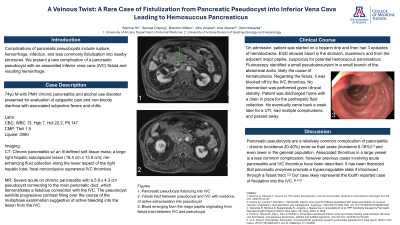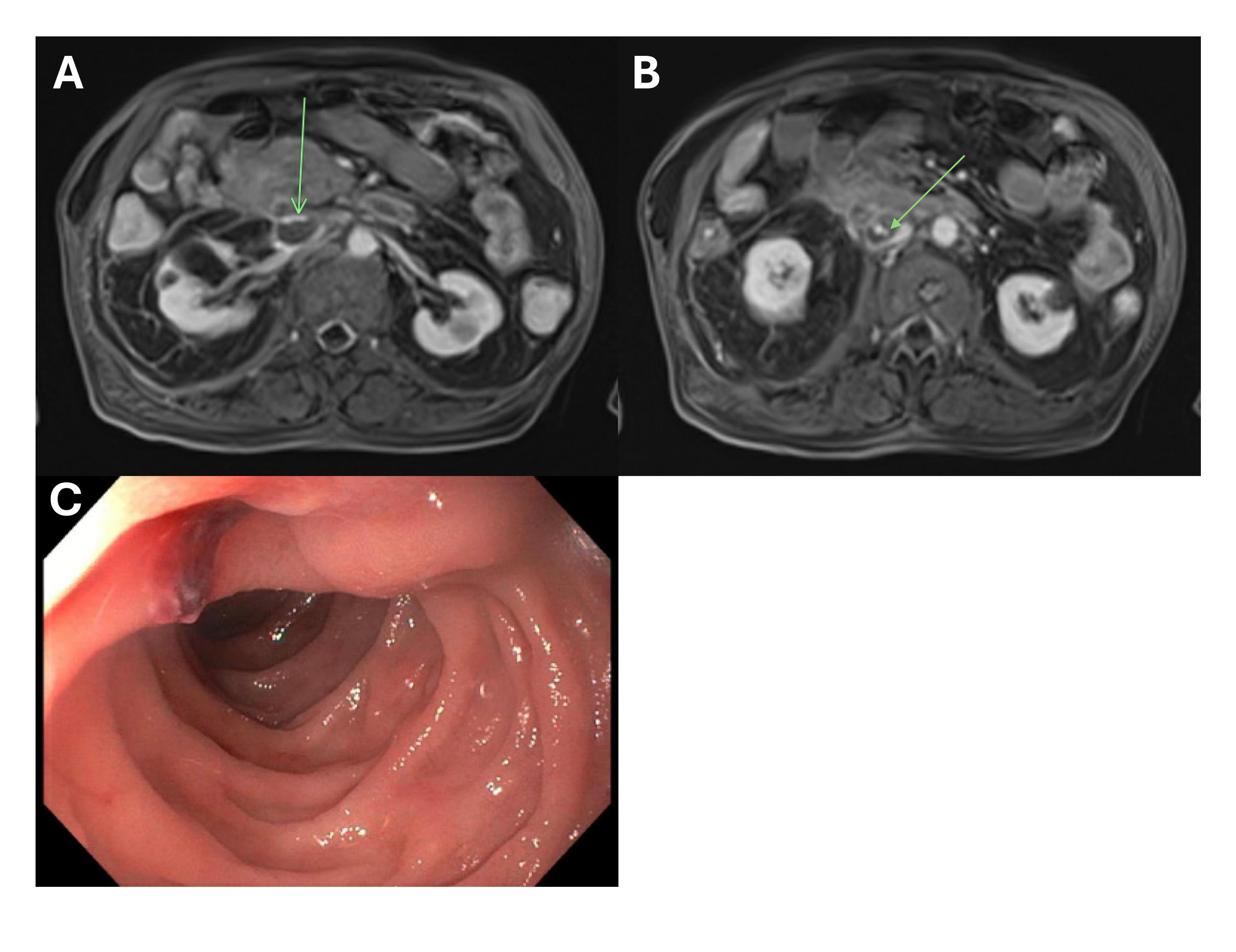Tuesday Poster Session
Category: Biliary/Pancreas
P3586 - A Veinous Twist: A Rare Case of Fistulization from Pancreatic Pseudocyst into Inferior Vena Cava Leading to Hemosuccus Pancreaticus
Tuesday, October 29, 2024
10:30 AM - 4:00 PM ET
Location: Exhibit Hall E

Has Audio

Sabrina Ho, MD
Banner - University of Arizona
Tucson, AZ
Presenting Author(s)
Award: Presidential Poster Award
Sabrina Ho, MD1, Samuel H. Cheong, DO1, Brandon Witten, MD2, Joseph Gunderson, 2, John Azizian, MD1, Aws Alameri, MD1, Oleh Haluszka, MD2
1Banner - University of Arizona, Tucson, AZ; 2University of Arizona College of Medicine, Tucson, AZ
Introduction: Complications of pancreatic pseudocysts include rupture, hemorrhage, infection, and less commonly fistulation into nearby structures. Fistula formation between a pseudocyst and major blood vessel can be disastrous. We present a rare complication of a pancreatic pseudocyst with an associated inferior vena cava (IVC) fistula and resulting hemorrhage.
Case Description/Methods: A 74-year-old male with a past medical history of chronic pancreatitis and alcohol use disorder presented for evaluation of epigastric pain, requiring copious amounts of NSAIDs, and non-bloody diarrhea. Initial workup was significant for a hemoglobin of 7.7 g/dL and a lipase of 3060 U/L. CT imaging demonstrated chronic pancreatitis with an ill-defined soft tissue mass, a large right hepatic subcapsular lesion (18.4 cm x 13.9 cm) as well as a rim-enhancing fluid collection along the lower aspect of the right hepatic lobe. Additionally, a focal nonocclusive suprarenal IVC thrombus was identified for which he was started on a heparin drip. MR abdomen was later performed which demonstrated a fistulous connection to the IVC.
Following MRI, the patient had three episodes of lower GI bleeding with hemodynamic instability. CTA abdomen was negative for active GI hemorrhage or pseudoaneurysm. EGD showed blood from the adjacent major papilla, suspicious for potential hemosuccus pancreaticus, frank red blood in the duodenum, and hematin in the stomach. Hepatobiliary surgery, vascular surgery, and interventional radiology (IR) were consulted, but ultimately each recommended medical management. The IVC thrombus was determined to be occluding off the fistula, therefore they opted not to pursue additional procedural intervention on the IVC thrombus. Fluoroscopy identified a small pseudoaneurysm from a small caliber branch of the abdominal aorta which was believed to be the cause of the hematochezia. IR subsequently placed a drain into the hepatic fluid collection, which was positive for amylase and lipase, and patient was discharged with the drain.
Discussion: Pancreatic pseudocysts are a relatively common complication of pancreatitis. Associated thrombus in a large vessel is a less common complication; however previous cases involving acute pancreatitis and IVC thrombus have been described in the literature. It has been theorized that pancreatic enzymes promote a hypercoagulable state if introduced through a fistula tract. Our case likely represents the fourth reported case of fistulation into the IVC.

Disclosures:
Sabrina Ho, MD1, Samuel H. Cheong, DO1, Brandon Witten, MD2, Joseph Gunderson, 2, John Azizian, MD1, Aws Alameri, MD1, Oleh Haluszka, MD2. P3586 - A Veinous Twist: A Rare Case of Fistulization from Pancreatic Pseudocyst into Inferior Vena Cava Leading to Hemosuccus Pancreaticus, ACG 2024 Annual Scientific Meeting Abstracts. Philadelphia, PA: American College of Gastroenterology.
Sabrina Ho, MD1, Samuel H. Cheong, DO1, Brandon Witten, MD2, Joseph Gunderson, 2, John Azizian, MD1, Aws Alameri, MD1, Oleh Haluszka, MD2
1Banner - University of Arizona, Tucson, AZ; 2University of Arizona College of Medicine, Tucson, AZ
Introduction: Complications of pancreatic pseudocysts include rupture, hemorrhage, infection, and less commonly fistulation into nearby structures. Fistula formation between a pseudocyst and major blood vessel can be disastrous. We present a rare complication of a pancreatic pseudocyst with an associated inferior vena cava (IVC) fistula and resulting hemorrhage.
Case Description/Methods: A 74-year-old male with a past medical history of chronic pancreatitis and alcohol use disorder presented for evaluation of epigastric pain, requiring copious amounts of NSAIDs, and non-bloody diarrhea. Initial workup was significant for a hemoglobin of 7.7 g/dL and a lipase of 3060 U/L. CT imaging demonstrated chronic pancreatitis with an ill-defined soft tissue mass, a large right hepatic subcapsular lesion (18.4 cm x 13.9 cm) as well as a rim-enhancing fluid collection along the lower aspect of the right hepatic lobe. Additionally, a focal nonocclusive suprarenal IVC thrombus was identified for which he was started on a heparin drip. MR abdomen was later performed which demonstrated a fistulous connection to the IVC.
Following MRI, the patient had three episodes of lower GI bleeding with hemodynamic instability. CTA abdomen was negative for active GI hemorrhage or pseudoaneurysm. EGD showed blood from the adjacent major papilla, suspicious for potential hemosuccus pancreaticus, frank red blood in the duodenum, and hematin in the stomach. Hepatobiliary surgery, vascular surgery, and interventional radiology (IR) were consulted, but ultimately each recommended medical management. The IVC thrombus was determined to be occluding off the fistula, therefore they opted not to pursue additional procedural intervention on the IVC thrombus. Fluoroscopy identified a small pseudoaneurysm from a small caliber branch of the abdominal aorta which was believed to be the cause of the hematochezia. IR subsequently placed a drain into the hepatic fluid collection, which was positive for amylase and lipase, and patient was discharged with the drain.
Discussion: Pancreatic pseudocysts are a relatively common complication of pancreatitis. Associated thrombus in a large vessel is a less common complication; however previous cases involving acute pancreatitis and IVC thrombus have been described in the literature. It has been theorized that pancreatic enzymes promote a hypercoagulable state if introduced through a fistula tract. Our case likely represents the fourth reported case of fistulation into the IVC.

Figure: A. Pancreatic pseudocyst fistulizing into IVC. B. Fistula tract between pseudocyst and IVC with evidence of active extravasation into pseudocyst. C. Blood emerging from the major papilla originating from fistula tract between IVC and pseudocyst.
Disclosures:
Sabrina Ho indicated no relevant financial relationships.
Samuel Cheong indicated no relevant financial relationships.
Brandon Witten indicated no relevant financial relationships.
Joseph Gunderson indicated no relevant financial relationships.
John Azizian indicated no relevant financial relationships.
Aws Alameri indicated no relevant financial relationships.
Oleh Haluszka indicated no relevant financial relationships.
Sabrina Ho, MD1, Samuel H. Cheong, DO1, Brandon Witten, MD2, Joseph Gunderson, 2, John Azizian, MD1, Aws Alameri, MD1, Oleh Haluszka, MD2. P3586 - A Veinous Twist: A Rare Case of Fistulization from Pancreatic Pseudocyst into Inferior Vena Cava Leading to Hemosuccus Pancreaticus, ACG 2024 Annual Scientific Meeting Abstracts. Philadelphia, PA: American College of Gastroenterology.

